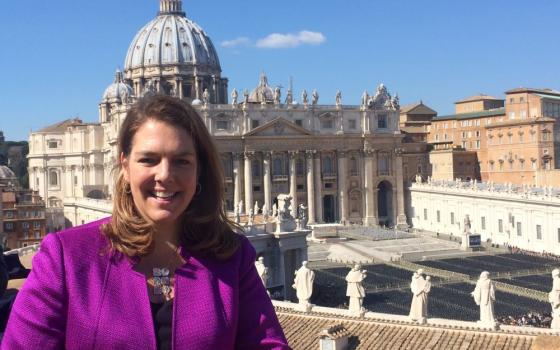When I was in grad school, a professor once had my class on ancient Rome read a letter from a young nobleman to his parents, in which he breathlessly described the connections he was making in high society and his ambitions for a senatorial career. The catch was that the letter was dated 476 A.D., the same year which historians now regard as marking the fall of Rome, when the last Western emperor was deposed by a Germanic chieftain.
The lesson was that sometimes historical turning points are lost on the people who actually experience them -- it takes time for their real meaning to emerge.
In Catholic terms, something analogous may have happened last week. In case you missed it, here’s the story in a nutshell: In a stunning and unexpected development, the European Court of Human Rights reversed its own 2009 ruling and upheld Italy’s right to display crucifixes in its public school classrooms. The deeper significance is that public expressions of religious belief have been found not to conflict with European standards of human rights and freedom of conscience.
Though it may not have burned up airwaves in the States, the story nonetheless has significance far beyond the borders of Europe, and here’s why.
Vis-à-vis what Christian tradition talks about as “the world,” there have always been two basic schools of thought. One is what we might call an “open door” policy, emphasizing dialogue with the world, presuming its good will and meeting it halfway, because that’s what evangelization means. The other is a “fortress” instinct, seeing the world as fundamentally hostile, and thus seeking a more inward-looking church capable of staying true to itself.
So far, the opening years of the 21st century have been a boom time for the fortress mentality in Catholicism, especially at the leadership level. Church/state clashes over abortion and homosexuality, coupled with perceptions that the church has become a scapegoat for a much broader social problem with sexual abuse, have fueled an increasingly defensive psychology.
Many church leaders have become more prone to interpret disagreement as defiance, more cautious about contamination by secular values, and less inclined to explain themselves to people they believe don’t really want to understand.
However understandable those reactions may be, they obviously make dialogue more difficult. In that context, the take-away from last Friday’s ruling cuts neatly in the opposite direction: “Maybe détente is possible after all.”
The outcome could recalibrate Catholic attitudes towards secularism at the gut level, providing a powerful boost for the “open door” approach. For bonus points, it’s also generated fresh ecumenical and inter-faith momentum … not bad for a day’s work.
Based in Strasbourg, the Court of Human Rights handles cases arising under the 1953 European Convention on Human Rights. An Italian parent named Soile Tuulikki Lautsi (who holds dual Finnish and Italian citizenship) had filed a complaint charging that display of a crucifix in schools where children are compelled to attend violates their rights. In November 2009, the court agreed. It doesn’t have the power to order the crucifixes down, but it imposed a 5,000 Euro fine on Italy for what it called “moral prejudice.”
Inside the Vatican, it’s almost impossible to overstate the psychological impact of that decision. Among many senior officials, it was taken as proof positive that alleged secular neutrality to religion in today’s Europe often masks overt hostility. If Italy can’t even put up a crucifix in its schools, for God’s sake, what’s next?
The Italian government appealed, and was eventually joined by 20 other states out of the 47 which form the Council of Europe. (The Vatican was not a party to the appeal, although it made no secret of its support.)
The coalition tapped Joseph Weiler, a New York-based attorney who’s regarded as one of the world’s leading experts on European constitutional law, to make the case. Weiler selected what turned out to be a winning strategy: Taking down the crucifix, he insisted, is no more neutral than leaving it up. Both express a worldview, and the enlightened European position is to tolerate either choice.
The appeal was considered a long shot, given that several of the justices who make up the Grand Chamber of the Court of Human Rights were also part of the initial ruling. Yet by a landslide 15-2 vote, the court last Friday overturned the 2009 decision. The Vatican hailed the result as “historic,” asserting that it recognizes “at a highly authoritative and international juridical level, that the culture of human rights should not be opposed to the religious foundations of European civilization.”
Bottom line: The decision represents a victory for the view that when faced with what seems like incomprehension and hostility, the best response is to make arguments rather than to hurl anathemas. Especially at a time when Benedict XVI has called for a “New Evangelization” in the West -- which sort of presumes an “open door” psychology -- that’s no small thing.
Ecumenically, the most direct beneficiary is the relationship between Catholicism and Orthodoxy.
Scanning the list of nations which joined Italy in the appeal, they include Russia, Greece, Ukraine, Serbia, Austria, Poland, Hungary, Croatia and Slovakia -- basically, the major Orthodox nations of Europe plus the component pieces of the old Habsburg Empire. One way to look at the result, therefore, is as a victory for a Catholic/Orthodox alliance, beating back the continent’s most secularized societies.
Among other things, the result provides new ammunition for moderate Orthodox leaders to justify dialogue with the Catholic Church, against hard-liners who see ecumenism with Rome as an abomination.
Finally, there’s also an inter-religious dimension. For instance, the ruling has made some Turkish Muslims feel better about their prospects in the EU -- that Europe will perhaps be open to their expressions of Islamic identity too.
Beyond that broad point, the ruling has special implications for Catholic/Jewish relations, for reasons which are mostly biographical. As it happens, Weiler, the lawyer who successfully led the appeal, is an Orthodox Jew.
The sight of Weiler standing in the well of the Grand Chamber of the European Court of Human Rights in his kippah, passionately defending Italy’s right to keep the crucifix on the wall, has got to rank among the more remarkable bits of inter-faith imagery in recent memory. (By the way, video of his oral argument is available on YouTube, and it’s well worth a look.)
Weiler’s celebrated role in the crucifix case, combined with other recent positive developments -- such as Pope Benedict XVI’s statements that Jews are not to blame for the death of Christ, and that Christians shouldn’t be trying to convert them -- provide basis for hope that Catholic/Jewish relations may be entering an extended upswing.
In the abstract, a citadel of European secularism is about the last place most Catholics would expect a favor, yet that’s precisely what the church got last Friday. How big a favor it turns out to be will depend, among other things, on the extent to which Catholics take its lessons to heart.
[John L. Allen Jr. is NCR senior correspondent. He can be reached at jallen@ncronline.org.]
Editor's Note: We can send you an e-mail alert every time John Allen's column, "All Things Catholic," is posted to NCRonline.org. Go to this page and follow the directions: E-mail alert sign-up. If you already receive e-mail alerts from us, click on the "update my profile" button to add "All Things Catholic" to your list.




